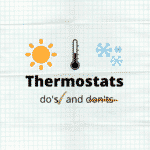
As the weather outside gets colder, you will probably start fiddling with your thermostat more to try and keep your home warm and toasty. Before you start cranking up the heat though, you’ll want to learn about some thermostat tips that can help you save on heating costs this winter. By avoiding common thermostat mistakes, you’ll be able to save both energy and money this winter regardless of if you use electricity or natural gas to heat your home.
If you want to find out which are the most frequent thermostat myths and facts, as well as the best ways of using a thermostat, read our full guide below.
The thermostat do’s: The best ways of using your thermostat
To start off, let’s talk about the best ways to use your thermostat.
1. Turn your thermostat during specific hours
During most days of the week, you’ll probably be out of the house for most of the day because of school or work. If no one’s going to be home, then there’s not much point in wasting energy to make your home super warm. At night, you’ll be in bed and not roaming around the house – so there’s also not much point in using a lot of energy in heating your home late at night.
According to Statistics Canada, lowering your house’s temperature to 16°C at night when you’re sleeping and when you’re not home can reduce the amount of gas you use by 13%, as well as save you approximately 2.3% in the amount of electricity used.
Conversely, you can save money in the summer via turning your thermostat up when you’re out or when you’re sleeping at night. By doing so, you can save 1-3% on your energy bill for every degree above 22 C you set your thermostat.
Regardless of the season, setting your thermostat correctly can cut down energy usage as well as your energy bills.
2. Considering using a programmable thermostat
A programmable or a smart thermostat differs from a regular thermostat in that it will learn your schedule and preferred heat settings. It’s a lot more convenient than having to change the settings on your thermostat every time you come home from work or every time you get up in the morning. The EPA’s Energy Star Program found that programmable thermostats can save you up to $180 a year on heating and cooling. So in summary, there’s a lot of benefits to using a smart thermostat – you’ll save on both energy and your energy bills, and your smart thermostat will pay for itself within a few years.
3. Clean your thermostat regularly
When you clean your home, it’s pretty likely that you don’t even realize that your thermostat is also something that needs to be cleaned. Did you know that running a dirty thermostat can increase your energy bill as much as 7%? Fortunately, cleaning your thermostat is simple – all you need to do is take off the cover and use compressed air to clean between contact points.
It’s important to note that if you’re not sure of how to do it, it’s best to hire a specialist, which will prevent you from breaking your thermostat or any other similar hiccups. Also, note that cleaning your thermostat only applies to regular thermostats – smart thermostats don’t need to be cleaned.
4. Compromise between comfort and temperature
While cranking up the thermostat will certainly make your home warm, it’ll also quickly make your energy bill quite expensive. So, in the winter, you should find out what the lowest temperature you can still feel comfortable at is. Around 22 degrees Celsius is a good starting point for when you’re at home but aiming to reduce that to 20 degrees Celsius can help you save on your energy bill. If you layer up with sweaters, cardigans and socks, you’ll hardly feel any difference at all.
In the summer, you can use fans to help cool you off and you’ll be able to keep your thermostat at a higher temperature and save a significant amount on your energy bill.
Balancing energy savings and comfort isn’t always easy, but it’s crucial to guarantee that you feel comfortable, safe and healthy at home. It isn’t exactly smart to turn the thermostat off and then have to spend money on medicines two weeks later because you got a cold.

The thermostat don’ts: How NOT to use your thermostat
Now that you know what the best ways of using your thermostat are, we can move on to what you shouldn’t do with your thermostat and what common misconceptions people have about these devices.
1. Try to heat your home faster by setting your thermostat to a higher setting
It can be tempting to crank up your thermostat after you’ve been outside in the cold, but did you know that doing that doesn’t actually heat up your home any faster? The same principle applies for dialling down your thermostat to super-low temperatures in the summer in an attempt to cool your home faster.
By setting your thermostat to extreme temperatures, you’ll actually be consuming more energy since your furnace or air conditioner would be running longer than if they were only trying to heat or cool your home to moderate temperatures.
In summary, being patient and waiting for your furnace or air conditioner to heat or cool your home to a moderate temperature will help you save on energy.
2. Frequently change your thermostat setting
Constantly adjusting your thermostat will lead to your furnace and air conditioner running inefficiently. To use energy as efficiently as possible, you should run your thermostat settings for around 8 hours or longer.
In addition to energy inefficiency, frequently changing your thermostat settings will also add a lot of wear and tear to your thermostat, furnace and air conditioner. Frequently changing your thermostat settings can lead to you needing to replace your thermostat, furnace or air conditioner sooner than you would have had to otherwise.
3. Install your thermostat in a very warm or very cold room
Thermostats measure the temperature of a room via using different sensor types such as air sensors or floor sensors. If you install them in very cold or very warm rooms, it’s likely that your thermostat will inaccurately read the true temperature of your home. Thus, you’d potentially be using more energy to heat or cool your home than necessary.
When you’re installing a thermostat, make sure to position it away from direct sunlight, any windows and away from heat sources such as lamps or ovens. In addition to this, installing your thermostat around 5 feet above the ground can help ensure that your thermostat will accurately read the temperature of your home.
How can a thermostat help me save energy and money?
Thermostats enable you to have better control of your energy consumption. They stop the HVAC system whenever the room reaches the temperature set by the user. Without these devices, it would be quite hard to know when it’s time to turn the HVAC on or off. We would probably not only overheat our home but also overspend on heating. And the same would happen with the cooling system.
As long as you set it properly, your thermostat will be a useful, comfortable and energy-saving tool.
Let’s take a smart or programmable thermostat as an example. Your smart thermostat will remember your schedule and adjust your heating settings to minimize the amount of energy used to heat or cool your home (ie. via setting a lower temperature when you’re not at home in the winter). That directly translates to less energy used and a lower energy bill.
If you don’t want to invest in a smart or programmable thermostat, there are free ways of changing your thermostat usage that will also help you save energy and money. For example, you can just put on more clothing instead of turning up the thermostat on cold days.
Thermostat settings and features for businesses and commercial facilities
Commercial smart thermostats have particular features to improve the experience in the office or any type of business, as well as save on energy usage. All of these innovative technologies we talk about below are revolutionizing the way businesses control their heating, and air conditioning (HVAC) systems, and are easily found. The main ones to look for are:
- Energy Efficiency: As some businesses can be open and use heaters or air conditioners 24/7, saving on energy is essential. Advanced algorithms and scheduling capabilities allow some thermostats to minimize energy waste.
- Learning Functions: Some models learn from daily usage patterns to optimize temperature settings automatically. This feature improves comfort and efficiency without manual intervention.
- Portability: Some thermostats offer the convenience of adjusting and monitoring building temperatures from any location, via smartphones or computers.
- Reporting: Access to detailed energy use reports and analytics empowers businesses to make informed decisions about their energy management strategies, identifying waste or opportunities for additional efficiencies.
What would be the best temperature to set up the thermostat at a business?
A properly set smart thermostat can save a business money and help reduce its carbon emissions, however, there is a third, often not discussed advantage, which is employee satisfaction levels. According to the U.S. Occupational Safety and Health Administration (OSHA), a temperature range from 15 to 24 Celsius could be ideal for most businesses. This range can seem quite broad but it is designed to fit multiple business types and employee requests. For example, the thermostat settings for a restaurant may be different than at an office space. This can get even wider if you compare a medical office’s energy habits and needs to a large industrial plant. The region and how employees collectively perceive temperatures can also result in different ideal temperatures or settings.
Other ways you can save on energy bills in Canada
Although re-evaluating your thermostat use is a great way to save energy, there are many other ways you can also cut down your energy bills. One way is by comparing electricity and natural gas rates in your area. At EnergyRates.ca, you can see a list of all the available best energy providers and their available plans in your area.
EnergyRates.ca is a free and unbiased cost comparison tool that can help you compare electricity and natural gas rates all across Canada.
Regardless of if you’re a residential, business, commercial, large commercial or industrial consumer, the website can list the best available electricity and natural gas rates in your region. All you need to do is fill in your postal code and you will find a list of energy suppliers and their rates in your location.
Commercial energy consumers can get a custom free quote based on their energy consumption, whether you’re in Alberta, Ontario, Manitoba, British Columbia and Saskatchewan.
Learn more:











